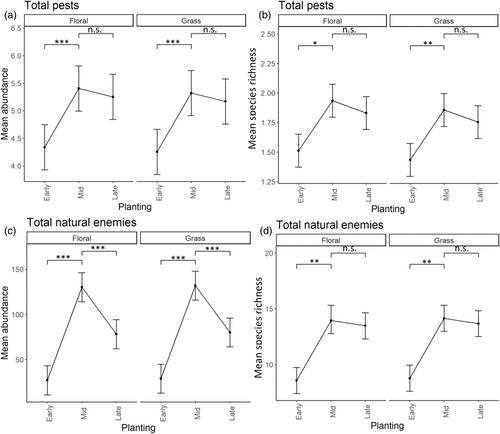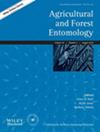结合生物防治方法管理田间作物害虫可产生互动效应
IF 1.8
3区 农林科学
Q2 ENTOMOLOGY
引用次数: 0
摘要
随着对农作物害虫的有效化学防治手段的丧失,转而采用生物防治手段是保护我们的农业系统未来的一种方法。田边花卉在减少作物害虫方面取得了成功,但其效果可能还不足以精确控制经济作物的虫害。昆虫病原线虫(EPNs)可提供更具物种和时间特异性的控制,将这些方法结合起来可能会产生协同效应。2022 年 3 月建立了三个田间植被边缘,每个边缘分为四个小区(两个花小区和两个草小区)。4 月、5 月和 6 月平行种植了三条发芽西兰花带。每个带状地块都采用分块设计,每个花卉/草地块旁放置四个线虫处理的八个重复:四种线虫处理分别是 Steinernema carpocapsae、S. feltiae 和 Heterorhabditis bacteriophora,以及无线虫对照。害虫压力通过成虫计数进行评估。此外,还评估了作物产量和与楔齿蛾(Contarinia nasturtii)特别相关的作物损害。研究发现,采用综合防治措施能成功控制更多害虫,但每种防治方法的成功与否在很大程度上取决于作物种植的时间。田边对豌豆穗螨造成的作物损害有很大影响。EPN H. bacteriophora 是一种有效控制甘蓝茎跳甲和豌豆穗螨的方法,还能减少作物损害和产量损失。田间边缘和 EPNs 对作物产量具有交互影响,这突出表明在未来的害虫综合治理研究中需要对防治方法进行综合测试,以准确了解它们在综合系统中的效果。本文章由计算机程序翻译,如有差异,请以英文原文为准。


Combining biological control approaches for managing insect crop pests in the field can generate interactive effects
求助全文
通过发布文献求助,成功后即可免费获取论文全文。
去求助
来源期刊

Agricultural and Forest Entomology
农林科学-昆虫学
CiteScore
3.60
自引率
6.20%
发文量
66
审稿时长
>24 weeks
期刊介绍:
Agricultural and Forest Entomology provides a multi-disciplinary and international forum in which researchers can present their work on all aspects of agricultural and forest entomology to other researchers, policy makers and professionals.
The Journal welcomes primary research papers, reviews and short communications on entomological research relevant to the control of insect and other arthropod pests. We invite high quality original research papers on the biology, population dynamics, impact and management of pests of the full range of forest, agricultural and horticultural crops.
 求助内容:
求助内容: 应助结果提醒方式:
应助结果提醒方式:


